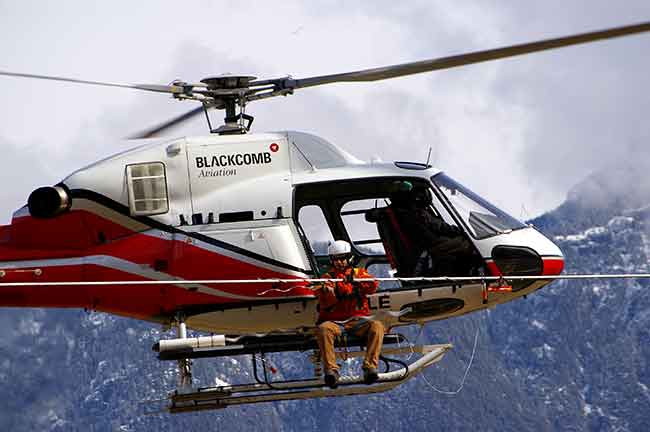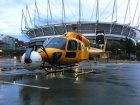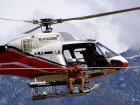
News
Dealing with the New Normal
July 14, 2016 By Paul Dixon
At the 2016 CHC Safety & Quality Summit in Vancouver, CHC CEO Karl Fessenden spoke to the a myriad issues facing the industry in general and his company in particular, and was very specific when highlighting current economic realities. He addressed his remarks to attendees in the big picture – business operators, suppliers, regulator and other industry partners – stressing that it was more important than ever to conduct “budget exercises,” “capital expenditure reviews,” and “cost benefit analyses” on all levels.
 Blackcomb Helicopters engaged in hydro line inspection. At the 2016 CHC Safety & Quality Summit in Vancouver
Blackcomb Helicopters engaged in hydro line inspection. At the 2016 CHC Safety & Quality Summit in VancouverFessenden spoke of how – only a year before – the world was cringing as oil prices had dropped to $60 a barrel and now, with oil hovering as low as $30, 2015 was already being referred to as the “good old days.” Fessenden added that in tough times, it’s critically important to focus on safety, both in daily operations and in long-term planning. Maintaining a safety focus, he noted, ensures an organization will have the core strength to grow with expanding markets in the future.
Just three weeks after Fessenden spoke in Vancouver, CHC suffered a catastrophic accident, when one of its EC225 Super Pumas (H225s) crashed into the ocean off of Norway, killing both pilots and 11 passengers. Just a week later, CHC announced the company was seeking Chapter 11 protection under American bankruptcy laws. A statement released by the company, quoted Fessenden noting that the process would give the company “an orderly path to enhance our financial flexibility and establish a competitive capital and operating structure” to grow the business in the long term. CHC’s day-to-day operations will remain as they are for now, but at the same time, the company is seeking to reorganize its fleet in a move that may see it shed two-thirds of the aircraft it currently operates by 2017.
While CHC grew out of Canadian roots and maintains a significant footprint in metro Vancouver with corporate offices in Richmond, B.C., and subsidiary Heli-One in Delta, B.C., there is a question of what impact, if any, the CHC announcement will have on the rotary-wing community in B.C., across Western Canada and the country as a whole. While the economic malaise afflicting Alberta’s oil patch has garnered the lion’s share of attention over the past couple of years, there has been a widespread slowdown through much of the energy and resource-based economy in Western Canada.
In B.C., for example, the provincial government is touting LNG exports to an energy-starved Asian market as the economic driver of the future, but these projects are dependent on the building of processing plants on the coast fed by pipelines from the source in the northeastern corner of the province. Pipelines are a contentious issue in B.C., with several projects seeking to build or expand existing pipelines to bring Alberta oil to the coast for shipment to world markets under intense opposition from a wide range of sources. And as projects are either shelved or stalled, critical work for helicopters is on hold right along with it.
Mining, which has been an economic driver in the province for decades, is suffering from a combination of depressed prices on world markets and increased environmental concerns. Coal mining in particular, has suffered as the Asian market for thermal coal has shrunk drastically and may never return. Forestry, the single economic driver in much of B.C. through the 20th century, has faced innumerable challenges from environmentalists, foreign tariffs on exports, falling demand for wood pulp and millions of hectares lost to insects and blight along with the demise of many of the legacy logging companies in recent years.
Logging, mining and mineral exploration and other resource-based industries were well-established long before helicopters were first introduced. Those first helicopters, few in number and limited in performance and capacity, were still able to establish themselves as a force multiplier, enabling both established businesses and new enterprises to do things in a way that wasn’t even imaginable before the helicopter was introduced.
In the late 1940s, it was the foresight and ingenuity of a handful of helicopter pioneers, including Carl Agar, Alf Stringer and Gerry Emerson to name but a few, who first employed their Bell 47s in aerial spraying and topographical survey work, where the helicopter first established itself as an invaluable tool. Helicopters were quickly embraced in a number of roles in southwestern B.C. – and on Vancouver Island – but the breakout performance was the role a handful of Bell 47s had in supporting the construction of the Alcan smelter project at Kitimat and especially in supporting the construction of the powerhouse at Kemano, in wilderness conditions. The use of helicopters was credited with cutting at least a year off the construction schedule.
Surviving the Downturns
The ingenuity and resilience that was demonstrated by the pioneer helicopter operators has lived on throughout the years, as the industry has found itself riding the rollercoaster through good times and bad. The strength of the industry in the eyes of Fred Jones, president of the Helicopter Association of Canada (HAC), has been its ability to rapidly change in response to the operating environment. Helicopters spoke to Jones about current economic realities as he was in the midst of a tour of B.C., visiting with association members.
“The industry has always been adaptable if nothing else,” Jones said. “I’ve been pleasantly surprised by what I’ve been hearing from operators this year. The price of lumber or the price of oil and gas are beyond their control. What we are seeing are more and more operators looking for a niche market or speciality that that will allow them to even out the peaks and valleys.” Some of those niche markets include survey work, aerial photography, specialty infrared scanning, and powerline work.
The low Canadian dollar can also have a positive impact on some sectors, for example, the forestry industry. The price of lumber is rising and there is a marked resurgence in heli-logging out west. Another benefit for the low dollar is the rise in American and European tourism, and many operators are reporting stronger interest in heli-tourism.
“Adaptability is what we are about,” Jones said. “Forward-thinking operators are exploring the niches, something that will stabilize them, then the seasonal stuff or price-dependent commodities is a bonus, depending on prices.”
Many operators in the B.C. region have established preferred areas of expertise, enabling them to stay profitable. For example, Brad Fandrich, general manager at Valley Helicopters in Hope B.C, hasn’t been severely affected by the economic slowdown in the VFR charter sector in B.C., mainly due to his firm’s diverse product offering. Valley offers support to a wide range of industries ranging from logging, mineral exploration and powerline construction to flying provincial avalanche technicians.
One company that has developed a large footprint in a particular niche is Wildcat Helicopters of Kelowna, B.C. Ian Wilson, vice-president of Wildcat Helicopters told Helicopters that many operators have seen economic conditions like these before – it is the nature of the business. He notes that Wildcat is “holding up well,” as its chosen area of operations has focussed on aerial firefighting, both in direct suppression and supporting heli-tack operations. For more than a decade, Wildcat has spent the Canadian winter down under, fighting fires in Australia. Coulson Aircrane, part of the Coulson Group of Companies, has been sending its S-61 machines to Australia for firefighting as well, more recently alongside its C-130 fixed-wing tankers. It’s a business tactic operators nationwide are utilizing.
Helijet of Vancouver has also shown an ability to diversify its product offering to deal with tougher economic realities. The company has built its reputation as the world’s largest rotary-wing scheduled airline, as well as providing air ambulance service to the province of B.C. In addition to its legacy Vancouver-Victoria route, in 2015 Helijet, initiated daily scheduled service between Vancouver and Nanaimo, supporting a growing number of professionals who choose to work in downtown Vancouver while living on Vancouver Island. When passenger loads on the Vancouver Island commuter routes drop, Helijet picks up the slack by moving aircraft up the coast to provide service to many of the exclusive fishing lodges in Haida Gwaii and on B.C.’s central coast.
Vancouver built a reputation as a mecca for filmmaking many years ago, earning the designation Hollywood North. Talon Helicopters and Blackcomb Aviation have built an impressive list of credits for movies, TV shows and commercial shoots. While not the main part of its business offering, filmmaking is a nice business vertical for the company. Blackcomb offers a wide range of services from power line construction and maintenance to backcountry skiing and scenic tours from its base at Whistler.
Seeing the Forest for the Trees
Heli-logging is also making a comeback on Vancouver Island, but there is a different approach from some operators. Since Tim Stinson of Stinson Aerial Services came home to Vancouver Island five years ago, he says there’s been a bit of a shakeout. Five years ago, there was a real mix of aircraft on the jobs: heavy life C-47 Chinooks, S-64, K-MAX, Kamov and the S-61. He’s seen a shift in the size of aircraft.
“Now, you are seeing them moving into the medium and medium-heavy – such as the Kamov, S-61, Vertol,” he said. “The timber profile seems to be more appropriate and the flies are getting a lot longer. Where we used to be 500 metres, now we are talking 1,000 metres plus.” Stinson just finished a project on the north end of Vancouver Island that has great implications for the future.
“We flew a K-MAX and a S-64 together. The 64 led the logging and the K-MAX supported it. My focus with what we do is the falling first. We try and find the most experienced guys in the industry, for example, and we combined two falling groups, which was new to a lot of people. We made sure we used the long ground where we could, we used all the tools we had – jacks. Then, we used calculators, we developed an app, so we can punch in diameters and calculate the optimal length we can fly and balance that with the value.”
The goal of the project is to identify prime timber at the source and cut it with tender-loving care. “We are already seeing wood with a lack of fracture at the sort,” Stinson said. “We want to be able to track that through the mill and see the uptick in value.”
The old growth timber is becoming increasingly valuable because there is less of it and what remains is becoming increasing isolated, which therefore creates the need for helicopters. The prime timber is only handled three times, a significant reduction over conventional techniques, where every time the wood is handled increases the likelihood of damage and diminished value. The hope is that this technique may see an increase in price by as much as 25 per cent.
Fessenden’s remarks about emphasizing training in times of economic downturn have never been truer for Abbotsford, B.C.’s Chinook Helicopters, Canada’s largest rotary-wing flight school. Clayton Reid of Chinook says the school was busy during the big “crash” of 2008 and its business has been growing steadily over the years.
If there are pilots displaced by the slow-down in the offshore oil and gas business, Clayton doesn’t see too many of them coming home. “They tend to have specific skills and get picked up by other companies in the international market, because Canadian pilots are very sought after in the world market,” Reid said. One trend the team at Chinook has noticed is the number of current helicopter pilots that are starting to retire, whether by aging-out or retiring. It’s a trend that has been noted industry wide and when the market does return, there will be a definite surge for more qualified pilots.
Staying Committed to a Plan
Helicopter operators aren’t the only ones feeling the pinch in a complicated marketplace. Airbus Helicopters Canada communications coordinator Laura Scott says her company remains committed to its main business segments and model. The team realizes the helicopter business is cyclic and they expect a slow and steady recovery through the next five to 10 years as prices for oil and other commodities recover. The future for Airbus Helicopters Canada remains focused on upgrading the Canadian fleet of helicopters, which the management team characterizes as “among the oldest in the world, with a majority of the aircraft over 30 years old.”
It’s much the same story at Bell Helicopters Textron Canada in Mirabel, Que. Currently, there are more than 1,000 Bell aircraft operating in Canada in all regions. The company’s long-term presence in Canada was recently strengthened with the transition of the Bell 505 Jet Ranger X assembly and final delivery to the Mirabel facility. In announcing the Mirabel move, Anthony Moreland, Bell’s vice president of North American sales, noted, “Mirabel will continue to be cornerstone of our global manufacturing, research and development, engineering and certification activities. Our operations in Canada have been, and will continue to be, a vital part of that global growth strategy.”
Bonds that Won’t Break
The helicopter industry in Canada is not a stack of dominoes or a house of cards. There is an interconnection between most if not all facets of the industry from the smallest operators to the large OEMs, but that connection looks more like a basket weave, where the strength of the whole is not dependent on any one component. Jones was correct in assessing the resilience and forward thinking of Canadian operators. The very nature of the business demands a level of awareness at all times and as Fessenden said, the same skills that enable a business to survive through the bottom of the cycle are the same skills that will enable it to thrive at the top.


